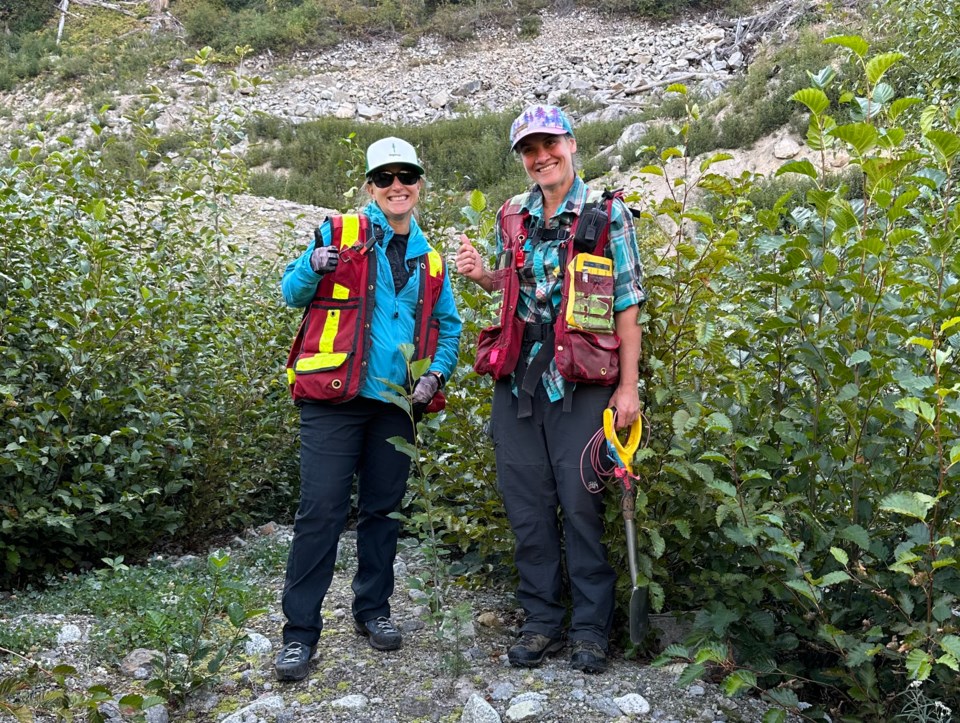Reforestation work at Mount Meager has been a huge success this summer in spite of the hot and dry conditions. The essential work aims to reduce flood risk for nearby communities including the Lil’wat Nation and Pemberton.
The 2010 Mount Meager landslide is considered one of the largest in Canadian history, with sediment still moving down the Lillooet River. Since then, local groups like the Pemberton Valley Diking District have been trying to stop the fast flow of the sediment. The most recent debris restoration project aims to build a new ecosystem atop Mount Meager while reducing flood risk downstream.
The project spearheaded by Veronica Woodruff Woodruff is senior project manager and principal with Clear Course Consulting and founder of the Pemberton Stewardship Society.
Woodruff has been working on the project in cooperation with the Lil’wat Nation since 2019.
“The initial part of the project was to develop the partnership,” she said. “From that partnership we were able to amass a broad group of interested universities, industries, business and governments to contribute to the project. The Ministry of Forests came with funding in 2022 to start to do some ground work. We were able to get onto the slide debris in the spring of 2023. We planted 33,000 trees.”
The trees were planted on the Capricorn Creek landslide site, the first of many on the group’s list. The workers took a different approach to planting this year, trying innovative ways of getting the trees to take.
“Because we’re not planting for timber harvest, we were able to plant different shrubs and trees,” said Woodruff. “We could actually look at restoring some value on the slide debris. The slide occurred in 2010, and there has been little regeneration in most of the slide debris.
“We did something that has never been done before. We planted coniferous trees with a plug of an alder in the same hole. We actually co-planted coniferous and deciduous trees together.”
Woodruff explained alder can fix nitrogen. “Not only could that double plant potentially retain more moisture, but that alder could act a bit like a fertilizer tree to give it a bit of a boost.”
The group’s great expectations were crushed when a dry and hot summer arrived.
“We have been in a drought since June 2022,” said Woodruff. “We had these bittersweet moments in the spring when we were finally there. We had all our trees. We had our planting crews. Driving up to the site, I cried. It was so hard, because everything was so dry and nothing was going to live.”
Woodruff and her troops stormed on regardless, praying for a miracle that eventually came. They planted the trees in areas near water with access to late afternoon shade.
“We got them in the ground and we just waited,” she said. “We had an incredibly hot and dry summer. We were just thinking that most things were going to be dead.”
Access to the site was prohibited all summer due to the large landslide risk. It wasn’t until September that the workers got to see the fruits of their labour.
“That morning over coffee, we said that the best we could hope for was 20-per-cent survival,” said Woodruff. “We were in a bit of a sombre mood. We got there and we had gotten close to 80-per-cent survival. It’s unbelievable!”
The expert thinks the high survival rate could be down to micro-site planting or increased morning dew moisture due to the narrowness of the valley. However, she admits we might never know why this summer, in particular, brought so many trees to life.
The importance of reforestation projects like this one cannot be overstressed as a means of reducing disastrous floods.
“One thing about that slide debris is that there is basically 15 million cubic metres of mountaintop sitting in the valley,” said Woodruff.
“That sediment is getting mobilized down the river. It’s settling in the river where people live. This affects flood risk in Pemberton, Mount Currie and throughout the regional district,” she added.
“The flood risk is increasing with this influx of new sediment. If we can recreate forests, then that will mitigate some of the sediment flow over time. Sediment flow is expected to continue over 60 to 80 years. This is just one part of a much broader picture.”




